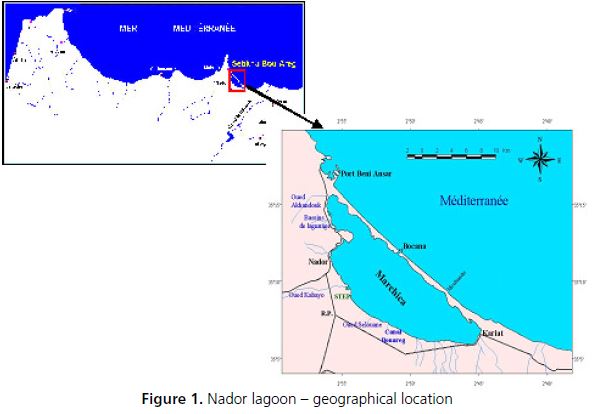8.2 General information on coastal lagoons
Only one coastal lagoon, Nador, is located on the Moroccan Mediterranean coast, between “Cap des trois fourches” and “Cap de l’eau”, the meridians 02°45’ and 02°55’W and the parallels 35°16’ and 35°06’ N (Fig. 1). It is also known as "Mar Chica" (small sea) or "Sebkha Bou-Areg". Its surface is about 115 km2, it communicates with the sea by a single gateway and has great fisheries and aquaculture potential. The Nador lagoon is listed as a site of biological and ecological interest.

Figure 1. Nador lagoon – geographical location
Table I: Nador lagoon – General information 
- Water and Forest Department - Marine Fisheries Department - Public Work Department
Marine Public Domain Fishers, aqua-culturists, tourists
From the geomorphologic point of view, the Nador lagoon is a natural depression formed by the action of movement of subsidence and eustatic forces. It is a micro-tidal paralic environment with an oval shape and its main direction is northwest - southeast. In the northeast, it is separated from the sea by a 25 km long consolidated dunes strip (called lido), aged from the Pleistocene; while in the southwest, it is separated from the continental land by the Gourougo massif and the Bou-Areg plain. This very dynamic environment undergoes significant changes related to both marine and inland intrusions. The lagoon bathymetry ranges between 1 and 8 m, with a maximum located in the central part (Houssa & Abdellaoui, 2002). Its bottom is characterized by fine fractions predominance (fine sand, clay silt). More than 90 percent of the sampling points showed sand that contains some organic detritus and sandy mud rich in organic matter localized in the central lagoon part (Abdellaoui et al., 2005).
In the past, the Nador lagoon was connecting with the sea through only one channel approximately 80 m wide. At the end of the 1970s, this channel was closed and a new 300 m wide channel was dug in the early 1980s. At the beginning of 2011, this communicating gateway was voluntary closed and a new one was opened in a closer area to ascertain sufficient exchanges between lagoon and sea. It is 300 m wide and is 6 m deeper; it is intended to improve seawater exchange and quality in this lagoon.
In recent years, increased urban development and population growth augmented the volume of wastewater that is unfortunately in most cases directly discharged into the lagoon (MedWetCoast, 2003). Wastewater treatment issues, increasing containment in the extreme areas and overall weak hydrodynamics have generated a long-term eutrophication, which could have a negative impact on ecosystem development and on its preservation.
The Nador lagoon belongs to the public maritime domain. The coastal dune separating the lagoon from the sea is part of the forest domain (private domain of the State). Resources are managed by the Marine Fisheries Department. The lagoon surface area was entirely allocated for aquaculture to Marost Company before its liquidation in 2006.